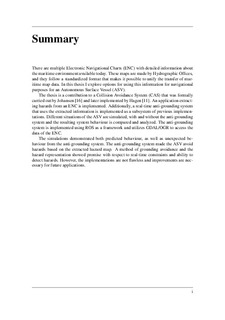| dc.contributor.advisor | Johansen, Tor Arne | |
| dc.contributor.advisor | Kufoalor, D. Kwame Minde | |
| dc.contributor.author | Otterholm, Ole Sivert | |
| dc.date.accessioned | 2019-10-15T14:00:18Z | |
| dc.date.available | 2019-10-15T14:00:18Z | |
| dc.date.issued | 2019 | |
| dc.identifier.uri | http://hdl.handle.net/11250/2622322 | |
| dc.description.abstract | Det finnes mange Elektroniske Navigasjonskart med detaljert beskrivelse om det maritime
miljøet tilgjengelig idag. Disse kartene er laget av hydrografiske kontorer, hvor de følger
et standardisert format som gjør det mulig ådele maritime kart. I denne oppgaven utforsker
jeg mulighetene for åbruke elektroniske kart for navigatoriske formål for et autonomt over-
flatefartøy.
Denne oppgaven er et bidrag til et anti-kollisjonssystem som er spesifisert formelt sett
av Johansen og senere implementert av Hagen. En applikasjon som ekstra-
herer farer fra et elektronisk kart er implementert. I tillegg er et sanntidssystem som
bruker de ekstraherte farene ogsåimplementert som et undersystem av tidligere imple-
menteringer. Et autonomt overflatefartøy er simulert i forkjellige situasjoner, med og
uten anti-grunnstøtningssystem, og resulterende oppførsel er sammenlignet og analysert.
Anti-grunnstøtningssystemet er implementert med bruk av ROS som rammeverk og bruker
GDAL/OGR for åaksessere den elektroniske kartdataen.
Simuleringene demonstrerte både forventet og uforventet oppførsel av anti - grunnstøt-
ningssystemet. Anti-grunnstøtningssystemet påvirket det autonome overflatefartøyet slik
at det unngikk de ekstraherte farene. En metode for åunngågrunnstøtning og represen-
tasjonen av farer viste lovende resultater med hensyn til sanntidsbegrensninger og evne til
åoppdage farer. Derimot, såer ikke implementasjonen feilfri og forbedringer er nødvendig
for fremtidige applikasjoner. | |
| dc.description.abstract | There are multiple Electronic Navigational Charts (ENC) with detailed information about
the maritime environment available today. These maps are made by Hydrographic Offices,
and they follow a standardized format that makes it possible to unify the transfer of mar-
itime map data. In this thesis I explore options for using this information for navigational
purposes for an Autonomous Surface Vessel (ASV).
The thesis is a contribution to a Collision Avoidance System (CAS) that was formally
carried out by Johansen and later implemented by Hagen. An application extract-
ing hazards from an ENC is implemented. Additionally, a real-time anti-grounding system
that uses the extracted information is implemented as a subsystem of previous implemen-
tations. Different situations of the ASV are simulated, with and without the anti-grounding
system and the resulting system behaviour is compared and analyzed. The anti-grounding
system is implemented using ROS as a framework and utilizes GDAL/OGR to access the
data of the ENC.
The simulations demonstrated both predicted behaviour, as well as unexpected be-
haviour from the anti-grounding system. The anti-grounding system made the ASV avoid
hazards based on the extracted hazard map. A method of grounding avoidance and the
hazard representation showed promise with respect to real-time constraints and ability to
detect hazards. However, the implementations are not flawless and improvements are nec-
essary for future applications. | |
| dc.language | eng | |
| dc.publisher | NTNU | |
| dc.title | Extracting Mapped Hazards from Electronic Navigational Charts for ASV Collision Avoidance | |
| dc.type | Master thesis | |
